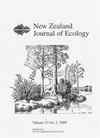Lighting trends reveal state of the dark sky cloak: light at night and its ecological impacts in Aotearoa New Zealand
IF 1.4
3区 环境科学与生态学
Q3 ECOLOGY
引用次数: 0
Abstract
: Artificial light at night (ALAN) exposes many organisms to increased night-time radiance and disrupts natural cycles that have cued the physiology and ecology of plants and animals throughout their evolutionary history. Here, we use satellite data to quantify spatiotemporal trends of ALAN in Aotearoa New Zealand between 2012–2021 and review the literature of the ecological impacts of ALAN. Our results show that the night-time light environment is changing rapidly in Aotearoa New Zealand: while the vast majority (95.2%) of the country had no direct emissions of ALAN, the lit surface area increased by 37.4% (from 3.0% to 4.2%) between 2012 and 2021. A total of 4694 km 2 of the country experienced increased brightness (median increase of 87%) over the decade. In contrast, 886 km 2 became less bright (median decrease 33%), mainly in urban centres where absolute brightness remains high. Our estimated increases in ALAN extent and brightness are underestimates as satellite imagery does not capture sky glow, nor the full extent of the light spectrum emitted by increasingly common light emitting diodes. Impacts of ALAN on the flora and fauna of Aotearoa New Zealand were identified from 39 pieces of literature, with most focussing on behavioural responses in avifauna, mammals, and insects. ALAN is an understudied environmental pollutant, as > 31% of the records described general observations rather than experimental or observational studies and literature describing impacts on groups including herpetofauna and marine mammals was absent照明趋势揭示黑暗天空的现状:新西兰奥特亚罗瓦的夜间照明及其对生态的影响
夜间人造光(ALAN)使许多生物暴露在夜间增强的辐射下,并扰乱了在整个进化历史中引导动植物生理和生态的自然循环。本文利用卫星数据定量分析了2012-2021年新西兰Aotearoa地区ALAN的时空变化趋势,并对ALAN生态影响的相关文献进行了综述。我们的研究结果表明,新西兰Aotearoa地区的夜间光环境正在迅速变化:虽然该国绝大多数地区(95.2%)没有ALAN的直接排放,但在2012年至2021年间,照明表面积增加了37.4%(从3.0%增加到4.2%)。在过去十年中,该国共有4694平方公里经历了亮度增加(中位数增加87%)。相比之下,886平方公里的亮度下降(中位数下降33%),主要是在绝对亮度仍然很高的城市中心。我们估计的ALAN范围和亮度的增加被低估了,因为卫星图像没有捕捉到天空的辉光,也没有捕捉到日益常见的发光二极管发出的光谱的全部范围。从39篇文献中确定了ALAN对新西兰Aotearoa地区动植物的影响,其中大部分集中在鸟类、哺乳动物和昆虫的行为反应上。ALAN是一种未被充分研究的环境污染物,因为> 31%的记录描述了一般观察结果,而不是实验或观察研究,并且没有文献描述对包括爬行动物和海洋哺乳动物在内的群体的影响
本文章由计算机程序翻译,如有差异,请以英文原文为准。
求助全文
约1分钟内获得全文
求助全文
来源期刊

New Zealand Journal of Ecology
环境科学-生态学
CiteScore
3.00
自引率
12.50%
发文量
35
审稿时长
>36 weeks
期刊介绍:
The New Zealand Journal of Ecology is a biannual peer-reviewed journal publishing ecological research relevant to New Zealand/Aotearoa and the South Pacific. It has been published since 1952 (as a 1952 issue of New Zealand Science Review and as the Proceedings of the New Zealand Ecological Society until 1977). The Journal is published by the New Zealand Ecological Society (Inc.), and is covered by Current Contents/Agriculture, Biology and Environmental Science, GEOBASE, and Geo Abstracts.
 求助内容:
求助内容: 应助结果提醒方式:
应助结果提醒方式:


